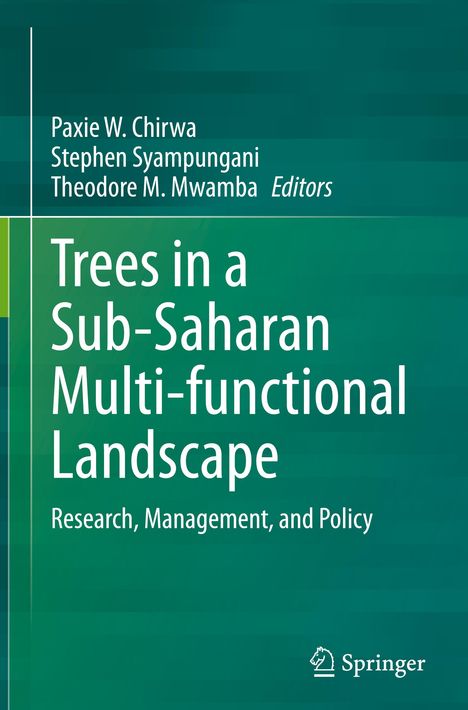Trees in a Sub-Saharan Multi-functional Landscape, Gebunden
Trees in a Sub-Saharan Multi-functional Landscape
- Research, Management, and Policy
(soweit verfügbar beim Lieferanten)
- Herausgeber:
- Paxie W. Chirwa, Theodore M. Mwamba, Stephen Syampungani
- Verlag:
- Springer Nature Switzerland, 10/2024
- Einband:
- Gebunden, HC runder Rücken kaschiert
- Sprache:
- Englisch
- ISBN-13:
- 9783031698118
- Artikelnummer:
- 11986854
- Umfang:
- 376 Seiten
- Nummer der Auflage:
- 2024
- Ausgabe:
- 2024
- Gewicht:
- 729 g
- Maße:
- 241 x 160 mm
- Stärke:
- 26 mm
- Erscheinungstermin:
- 2.10.2024
- Hinweis
-
Achtung: Artikel ist nicht in deutscher Sprache!
Klappentext
Africa is largely dependent on natural resources in its quest to achieve sustainable development goals, with its woodlands and forests known to be among the most exploited ecosystems. Anthropogenic pressure has led to the progressive conversion of these woodlands and forests into patches of regrowth stands, savanna and cropland systems. Expansion with intensification of agricultural land and the unsustainable use of fuelwood biomass are among the major drivers of such landscape transformations and the associated decline of biodiversity and ecosystem services. This phenomenon is growing in magnitude and significance with emerging environmental issues including climate change, biological invasion, and pollution arising from various land use practices, thereby jeopardizing Africäs development pathway.
Agroforestry holds promises to reverse this trend, as it provides the potential for designing multifunctional agricultural landscapes that guarantee trade-offs of food security, biodiversity conservation, and ecosystem services. Africa is characterized by highly variable ecological conditions and remarkable cultural diversity that influence the conception of landscape multifunctionality. Drawing upon the vast experience of researchers and many other professionals in Africa, this book contextualizes the roles of trees in African multifunctional landscapes, capturing the biophysical and societal diversity in the region, while scrutinizing the ongoing trend of landscape multifunctionality in Africa with reference to the global scenario. It is designed to provide a holistic and comprehensive understanding of the various roles of trees in African landscapes and shed light on the underlying functional attributes of trees, which will help readers to generate a better insight and problem-solving approach for landscape multifunctionality in the context of Africa.
This book defines the multifunctional landscapes with reference to an African context. The book has fourteen chapters, covering five broad thematic areas (i) the multiple services, functions and role of trees in multifunctional landscapes; (ii) tree-based production systems, products and their contributions to rural livelihoods; (iii) drivers of land cover changes and their impacts; (iv) approaches for managing resources to integrate trees in multifunctional landscapes; and (v) external factors affecting landscape resources management in Africa.

